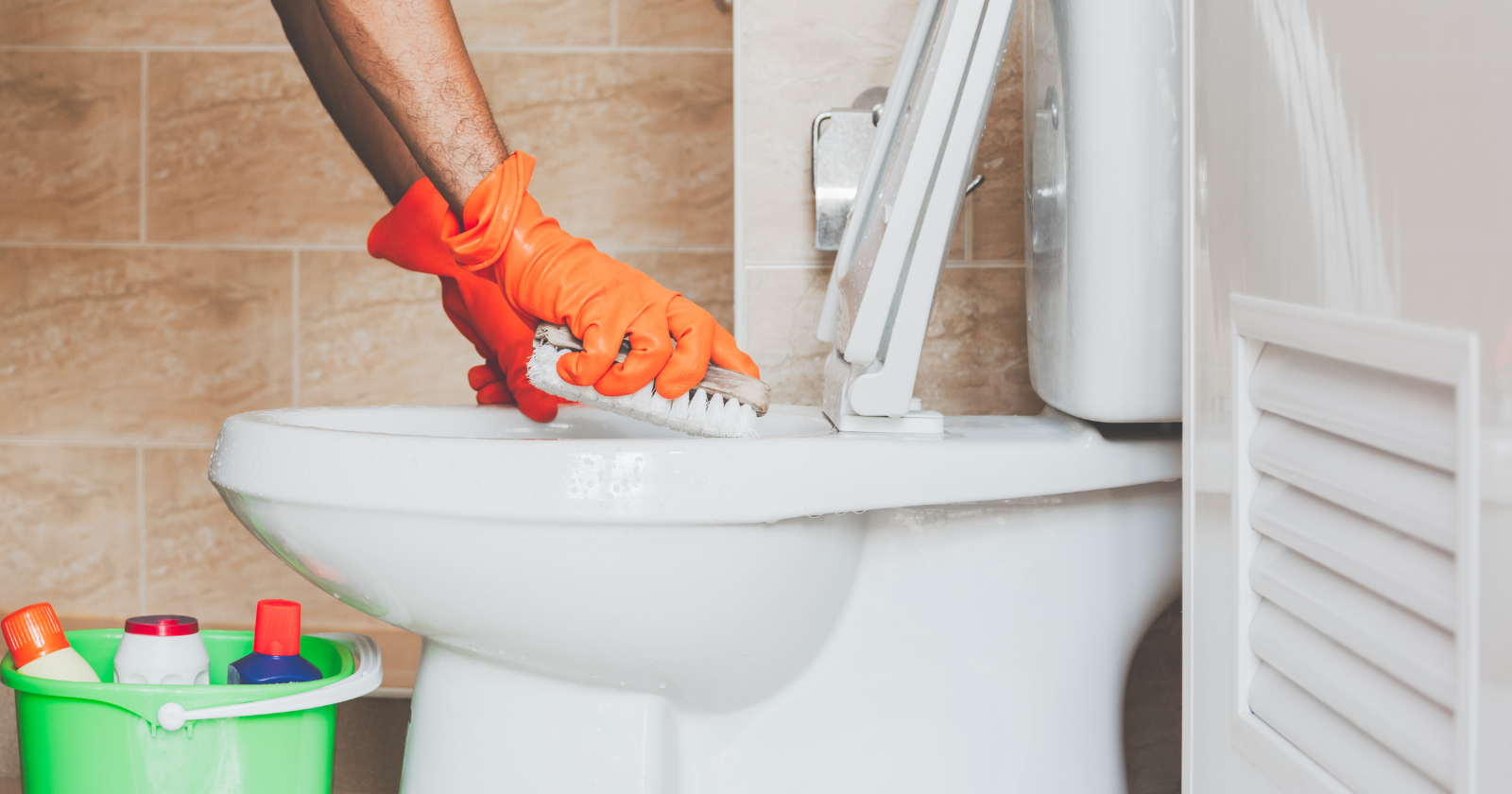
When maintaining a clean and hygienic bathroom, the toilet seat plays a crucial role. With so many options available, choosing the best toilet seat surface for cleaning can be overwhelming. Whether you’re looking for durability, ease of cleaning, or comfort, understanding the different materials and their benefits is essential. We’ll look at the top surfaces for toilet seats, highlighting their pros and cons to help you make an informed decision and keep your bathroom spotless with minimal effort.
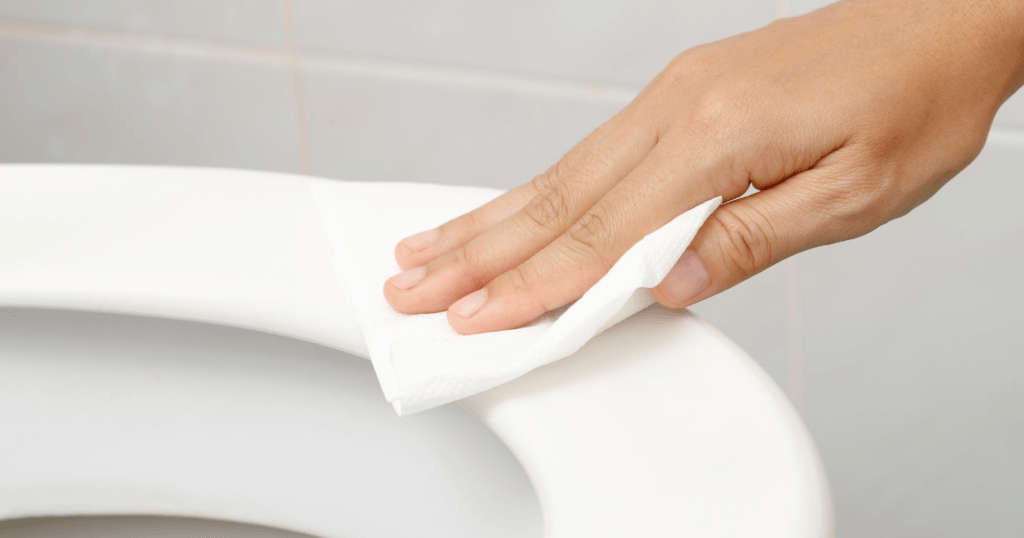
So, What is the Best Toilet Seat Surface for Cleaning?
When it comes to choosing the best toilet seat surface for easy cleaning, several factors come into play, including material, durability, and maintenance requirements. Here are the top materials to consider:
1. Plastic:
- Pros: Plastic toilet seats are popular due to their affordability and ease of maintenance. They are lightweight, resistant to moisture, and do not absorb stains or odors. Smooth plastic surfaces are easy to wipe down with standard household cleaners, making them a practical choice for busy households.
- Cons: While plastic seats are durable, they can become scratched over time, which may harbor bacteria if not cleaned thoroughly.
2. Wood (Enamel-Coated):
- Pros: Wooden toilet seats coated with enamel provide a classic look while offering ease of cleaning, similar to plastic. The enamel coating creates a smooth, non-porous surface that resists stains and moisture. They are also known for their durability and comfort.
- Cons: Over time, the enamel coating can chip, exposing the wood underneath to moisture and bacteria. Regular inspection and gentle cleaning are necessary to maintain their longevity.
3. Molded Wood:
- Pros: Molded wood seats are made from wood composite materials and coated with a durable finish. They offer the aesthetic appeal of wood while being more resistant to chipping and cracking than solid wood.
- Cons: They can be heavier than plastic seats, and while the finish is durable, it can still wear down over time with excessive cleaning or abrasive cleaners.
4. Thermoplastic (Polypropylene):
- Pros: Thermoplastic seats, particularly those made from polypropylene, are highly durable and resistant to chemical cleaners. Their non-porous surface makes them very easy to clean and maintain. They are also more flexible and resistant to cracking compared to standard plastic seats.
- Cons: They may not have the same luxurious feel as wood or high-end plastic options, but their practicality often outweighs aesthetic considerations.
5. Antimicrobial-Coated Seats:
- Pros: Some modern toilet seats come with antimicrobial coatings that inhibit the growth of bacteria and mold. These seats are particularly beneficial in households with young children or elderly individuals where hygiene is a top priority. The antimicrobial surface reduces the frequency of deep cleaning needed to maintain a sanitary environment.
- Cons: While effective, antimicrobial coatings can wear off over time, so it’s important to choose high-quality options and follow the manufacturer’s care instructions.
The best toilet seat surface for cleaning depends on your specific needs and preferences. Plastic and thermoplastic options offer the easiest maintenance, while enamel-coated wood provides a blend of aesthetics and functionality.
Antimicrobial-coated seats are an excellent choice for those seeking added hygiene benefits. Consider the pros and cons of each material to find the perfect balance between cleanliness, durability, and comfort for your bathroom.
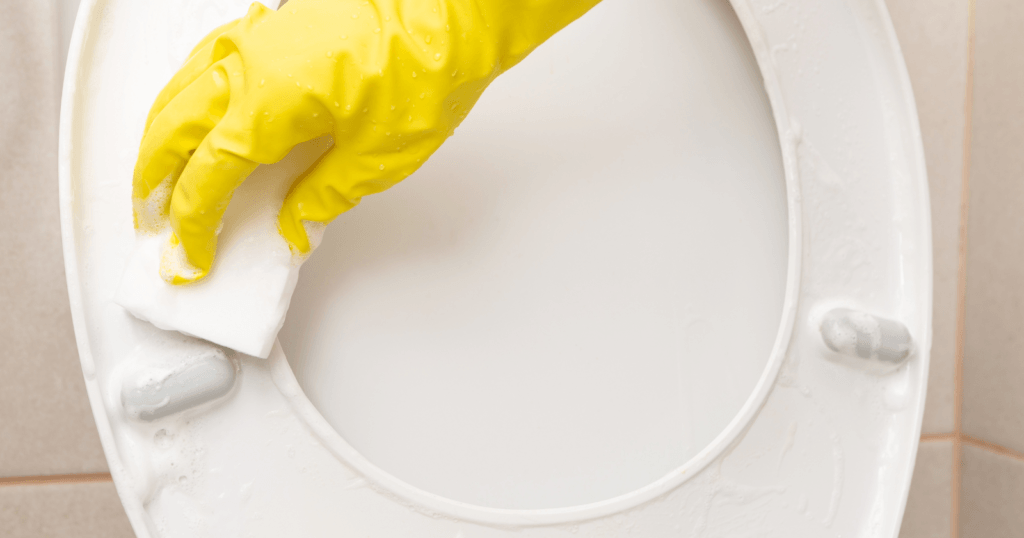
Materials and Tools for Effective Toilet Seat Cleaning
Using the right materials and tools is crucial for cleaning a toilet seat effectively. Specific cleaning agents and proper tool use can help achieve a hygienic and spotless result.
Choosing the Right Cleaning Agents
I recommend using a combination of vinegar and baking soda for effective cleaning. Vinegar acts as a natural disinfectant, killing germs and cutting through grime. Baking soda helps in scrubbing off tough stains without scratching the surface. For stronger sanitation, bleach is a good option but should be used with caution.
Hydrogen peroxide can be another alternative to remove mildew and sanitize the surface. Disinfecting wipes and sprays are handy for quick clean-ups. Choose a toilet bowl cleaner that matches your toilet’s material, and always ensure you follow the instructions on any commercial cleaning products.
Proper Use of Tools for Scrubbing and Wiping
Using the right tools makes the cleaning process more efficient. Always wear rubber gloves to protect your hands from harsh chemicals and bacteria. A sponge is ideal for wiping down surfaces, and a brush works well for scrubbing more stubborn spots.
For a thorough clean, I suggest using a cleaning solution of dish soap and warm water for a first pass. Follow up with a baking soda paste for any residual stains. Clean the areas around the hinges with a disposable wipe to avoid bacteria build-up.
Always rinse the tools thoroughly after use and store them in a clean, dry place. This ensures they are ready for the next cleaning session and prevents mildew formation.
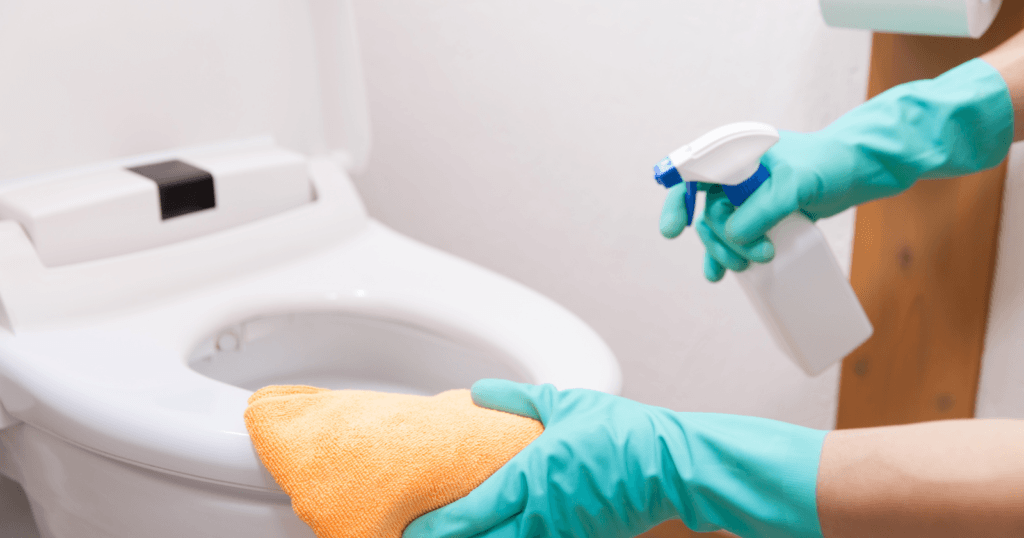
Step-By-Step Cleaning Guide
When cleaning a toilet seat, the key steps are removing stubborn stains and discoloration, disinfecting for germ-free surfaces, and using proper rinsing and drying techniques. Below, I’ll guide you through each process to ensure your toilet seat stays sparkling and hygienic.
Removing Stubborn Stains and Discoloration
Removing stains on a toilet seat requires the right approach. First, apply a toilet cleaner or a mixture of baking soda and vinegar to the stained areas. Urine stains and spots from hard water can be particularly tough. Let the solution sit for about 15 minutes to break down the stains.
Next, take a non-abrasive scrub brush or sponge. Scrub the stains using a circular motion, focusing on the stubborn spots. For hard-to-reach areas around the hinges or edges, use an old toothbrush. Rinse and check if the stains are gone. Repeat if necessary.
Disinfecting for Germ-Free Surfaces
Disinfecting is crucial for keeping the toilet seat germ-free. Bacteria and viruses can thrive on toilet surfaces. Start by applying a disinfectant spray specifically designed for bathrooms. Ensure that all areas of the seat, including the underside and hinges, are covered.
Allow the disinfectant to sit for at least 10 minutes. This ensures it kills germs effectively. Wipe the seat thoroughly with a clean cloth or paper towel. Don’t forget to clean the surrounding areas, such as the handle and the lid. For an extra layer of protection, follow up with disinfecting wipes.
Rinsing and Drying Techniques
After cleaning and disinfecting, proper rinsing and drying are essential. Use warm water to rinse off any leftover cleaning agents. Make sure to rinse off all parts of the toilet seat thoroughly.
Once rinsed, dry the seat with a clean, dry towel. Pay extra attention to corners and hard-to-reach areas to avoid moisture build-up, which can cause mold and mildew. For a sparkling finish, polish the toilet seat with a dry microfiber cloth. This helps remove any remaining spots and leaves the surface shining.

Maintenance and Regular Cleaning Practices
Keeping a toilet seat clean and hygienic requires consistent maintenance and regular cleaning using safe and effective techniques. Specific routines help prevent stains and ensure longevity.
Daily and Weekly Maintenance Routines
Daily cleaning is important for preventing the buildup of germs and stains. I wipe the toilet seat with a damp cloth or a disinfecting wipe each day. This removes any dirt and keeps the surface sanitary. It’s best to avoid harsh chemicals that can damage the material.
Weekly, a more thorough cleaning is needed. I sprayed a gentle cleaner onto the toilet seat, covering the entire surface. Letting the solution sit for a few minutes allows it to break down dirt and germs. Then, I scrub gently with a soft cloth or sponge, paying attention to any stubborn spots.
Ventilation is key during cleaning to avoid inhaling any fumes. Regular maintenance like this keeps the toilet seat in good condition and hygienic for daily use.
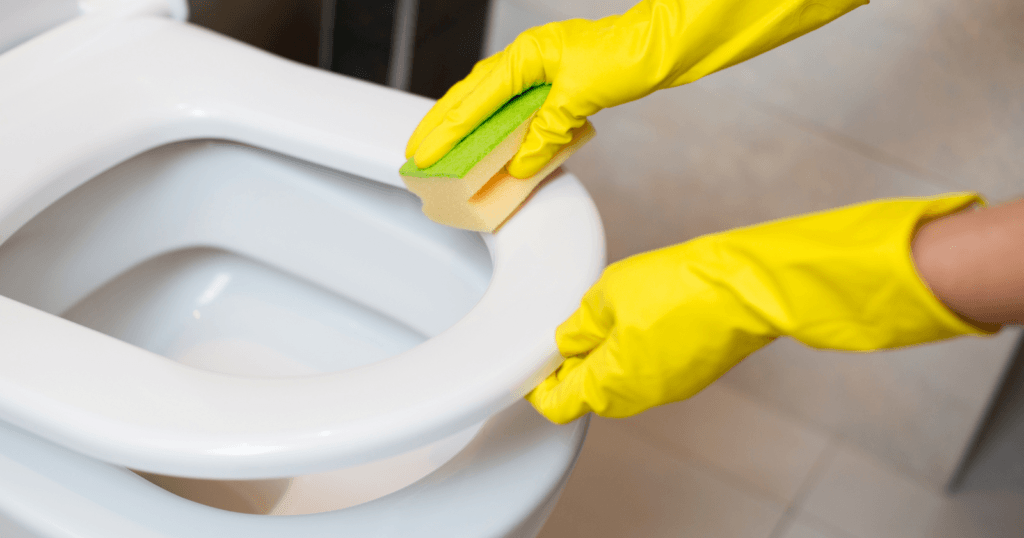
Special Considerations for Different Toilet Seat Materials
Knowing how different materials affect cleaning and maintenance is important when choosing a toilet seat. Factors like hard water, the type of cleaning products, and attention to hinges and covers all play a role.
Addressing Hard Water and Limescale
Hard water can leave unsightly limescale deposits on toilet seats and surfaces. Plastic toilet seats tend to resist these deposits better than porcelain surfaces.
A mixture of vinegar and baking soda can be effective for removing limescale. White vinegar is especially good for dissolving limescale and shouldn’t damage plastic surfaces. Pumice stones can be handy but use them sparingly to avoid scratches.
Distilled white vinegar is great for regular wipe-downs to keep metal hinges free of rust and buildup. Prevention is key; regularly clean to prevent heavy build-up.
Natural vs. Commercial Cleaning Products
You can choose between natural and commercial cleaning products when cleaning toilet seats. For instance, using white vinegar and baking soda can be a non-toxic option to remove stains and mold. This combination is effective and doesn’t emit harsh fumes.
You might need products like Clorox Toilet Bowl Cleaner with Bleach for stronger cleaning. This is particularly useful for disinfecting and removing stubborn stains. Use it carefully to avoid damaging the toilet seat cover.
Sometimes, commercial cleaners offer faster results, but frequent use of harsh chemicals might weaken certain materials over time. I recommend natural light cleaning solutions and commercial products for deep or occasional thorough cleanings.
Caring for Toilet Seat Hinges and Covers
Attention to hinges and covers is crucial for maintaining your toilet’s overall hygiene and look. If not cleaned properly, hinges can harbor bacteria and develop rust. When doing routine cleaning, use an all-purpose cleaner or vinegar and water solution.
For plastic toilet seats, use a scratch-free scouring sponge to avoid wear and tear. Commercial bathroom cleaners like Carolyn Forté’s recommended products can effectively remove grime from hinges without damaging them.
To keep metal parts like hinges rust-free, always dry them thoroughly after cleaning. Regular maintenance will prevent unpleasant smells and keep your toilet fresh and functional.
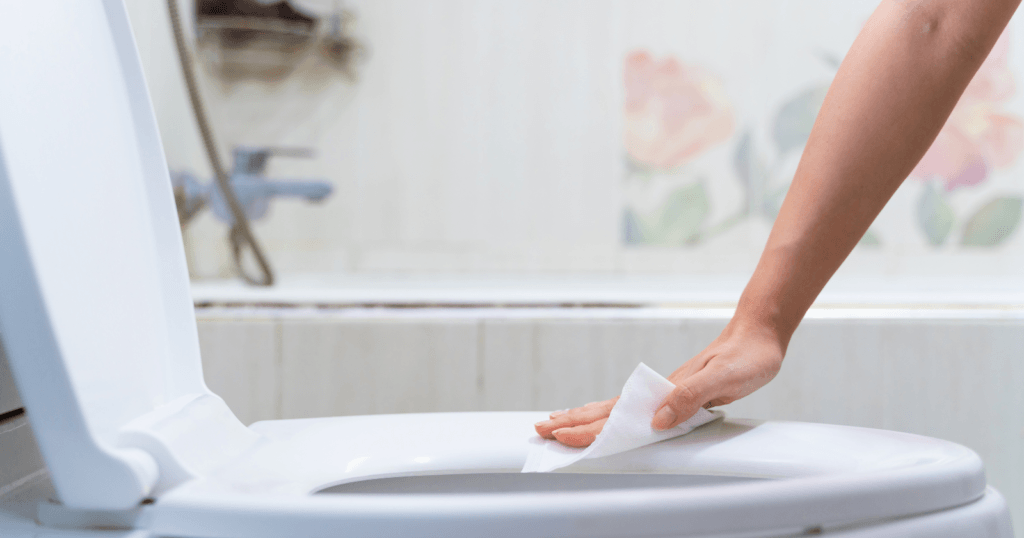
Wrapping Up
Choosing the best toilet seat surface for cleaning might not be the most glamorous decision you’ll make, but it can save you countless hours of scrubbing and sanitizing. Whether you choose plastic’s practicality, enamel-coated wood’s elegance, or antimicrobial coatings’ high-tech appeal, your bathroom will thank you.
Remember, a clean toilet seat isn’t just about hygiene—it’s about peace of mind. So, the next time you sit down, you can do so with the confidence that you’ve made the best choice for a spotless throne. Happy cleaning, and may your bathroom always sparkle!
Frequently Asked Questions
Toilet seats with wanderlust: How do I find one that’ll stay put?
We’ve all been there – a wobbly toilet seat that just won’t stay put. But fear not, my friends! Look for toilet seats with adjustable hinges and non-slip bumpers to ensure that your seat stays in place. Trust me, you’ll never have to deal with a wobbly seat again.
Wood versus plastic: Which toilet seat can survive the heavyweight championship?
It’s the age-old battle – wood versus plastic. But when it comes to toilet seats, plastic is the clear winner. Not only is it easier to clean and maintain, but it’s also more durable and can withstand the heavyweight championship. Sorry, wood, but it’s time to step aside and let plastic take the throne.
Dive Deep
- Top 3 Picks-Kohler Round Toilet Seat
- Are Toilet Seat Covers Sanitary
- Can Toilet Seat Covers Be Flushed
